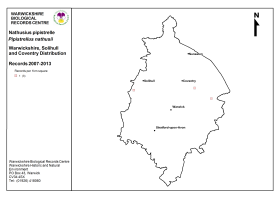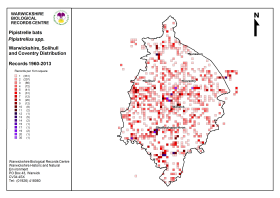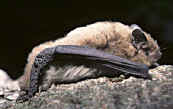Nathusius' Pipistrelle

Distribution map for Nathusius' Pipistrelle bats in Warwickshire. (Click for a full sized image)
 Nathusius' Pipistrelle (Pipistrellus nathusii) is very similar in
appearance to the Common Pipistrelle and the
Soprano Pipistrelle, although it is slightly
larger. The fur is often longer and paler tips give it a frosted appearance.
The underparts are pale grey-brown.
Nathusius' Pipistrelle (Pipistrellus nathusii) is very similar in
appearance to the Common Pipistrelle and the
Soprano Pipistrelle, although it is slightly
larger. The fur is often longer and paler tips give it a frosted appearance.
The underparts are pale grey-brown.
flight & ultrasound
Emerging in early dusk, Nathusius' Pipistrelle has a rapid flight with deep
wing beats when flying in a straight line. It forages 4 - 15 m above ground
along rides, paths, woodland edges and over water.
Nathusius' bats echolocation calls range from 38 - 70 kHz and are best
heard with a heterodyne bat detector set
to about 39 kHz where a series of clicks turns into 'wetter' slaps towards
the bottom of the frequency range. To identify the species of Pipistrelle
the frequency dial of the bat detector should be turned up and down until
the pitch of the 'wet slap' is at its lowest. It is worth paying special
attention to any bat with a 'low point' below 41 kHz.

Distribution map for all species of Pipistrelle bats in Warwickshire. (Click for a full sized image)
 Nathusius' Pipistrelle bat call on a Heterodyne bat detector.
Nathusius' Pipistrelle bat call on a Heterodyne bat detector.
 Nathusius' Pipistrelle bat call on a Time Expansion bat detector.
Nathusius' Pipistrelle bat call on a Time Expansion bat detector.
breeding
The first 2 breeding roosts of Nathusius' Pipistrelle in the UK were
found in 1997.
 Mating
occurs during early autumn at well established mating roosts. Males have
mating territories with harems of 3 - 10 females. Females can reach maturity
by their first year but most males will not reach sexual maturity until
the following year.
Mating
occurs during early autumn at well established mating roosts. Males have
mating territories with harems of 3 - 10 females. Females can reach maturity
by their first year but most males will not reach sexual maturity until
the following year.
Maternity colonies consist almost exclusively of female bats and are
occupied from May onwards. Females give birth to two young from late July.
The young are fed solely on their mother's milk and females with young
to suckle may make several feeding trips during the night, leaving the
young inside the roost in a group or crèche. Within three weeks the young
make their first flights and by six weeks they can forage for themselves.
Most colonies start to disperse soon after the young are weaned.
summer roosts
These are found in hollow trees, bat boxes, cracks in trees and more
rarely in buildings. They will sometimes share a nursery roost with other
Pipistrelles or Brandt's.
winter roosts
Nathusius' Pipistrelle tends to hibernate in crevices in cliffs, wall
cracks, caves and hollow trees.
For more information on this type of Pipistrelle check out the website
by Jon Russ: Nathusius'
Pipistrelle in Great Britain & Ireland
| Description |
|
| Head and Body Length |
46 - 55 mm |
| Forearm Length |
32 - 37 mm |
| Wingspan |
220 - 250 mm |
| Weight |
6 - 15 g |
| Colour |
Red or chestnut brown in summer, dark brown with grey
tips after July moult. |
|
|
| |
|
| Life Cycle |
|
| Mating Period |
Autumn. |
| Maternity Colonies |
Established late spring.
Young: two born late July, weaned at 6 weeks. |
| Colony Size |
50 - 200 |
| Longevity |
Up to 7 years. |
| UK Status |
Rare |
|
|
| |
|
| Habitat and Food |
|
| Summer Roosts |
Hollow trees or cracks in trees, bat boxes, occasionally
in buildings. |
| Winter Roosts |
Cliff crevices, wall cracks, caves and hollow trees. |
| Feeding Habitat |
Woodland bat - deciduous and pine forests, sometimes
parks. |
| Food |
Medium to large insects. |